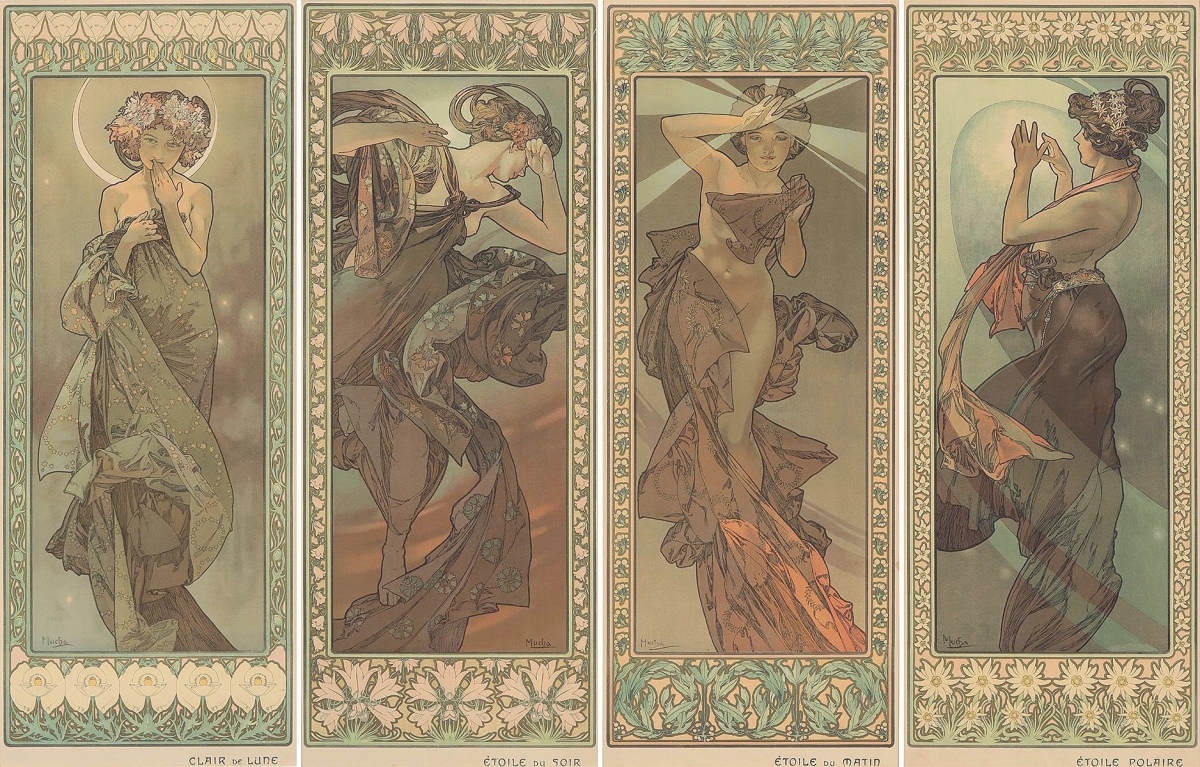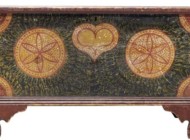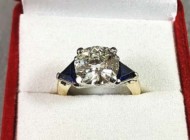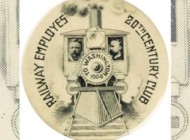
The Stars, 1902, by Art Nouveau master Alphonse Mucha (1860-1939) ascended to the top of the 500 rare and iconic works presented, selling for $72,000.
Review by W.A. Demers, Photos Courtesy Poster Auctions International
NEW YORK CITY – Poster Auctions International’s (PAI) first sale of the year on March 14 finished at $1.9 million in sales. The auction house said the event surpassed expectations, thanks to passionate collectors and first-rate consignments. Sell-through was 67 percent, engaging 400 registered bidders representing 21 countries and vying for lots on two online platforms.
Jack Rennert, president of PAI, said, “This sale featured one of the best collections we’ve had in recent memory, but none of us could have predicted the feverish action on auction day. Collectors exhibited an intoxicating zest for posters and bid competitively. Thanks to their enthusiasm, we achieved a number of never-before-reached winning bids.”
Among 500 rare and iconic works presented, the star was Art Nouveau master Alphonse Mucha’s (1860-1939) The Stars, which sold for $72,000 to a private collector.

Conveying the raw energy and speed on the racetrack was Belle Époque master Henri de Toulouse-Lautrec’s (1864-1901) 1899 Le Jockey, which was bid to $57,600, just below high estimate.
The sale catalog notes that in this series, Mucha began to see the decorative panel as painting with a meaning deeper than mere ornament. He connected his attraction to higher ideals, expressed through the stars, with his recurring theme of beautiful women personifying the stars as floating female figures. The dramatic quality of the movement of the individual figures is also remarkable, resembling the great baroque artistic heritage of Mucha’s country. Seen left to right in the illustration are the Moon, the Evening and Morning Stars – both aspects of Venus – and the North Star. And the flowery borders are virtual textbook examples of Art Nouveau as carried out by its master. The group represented the larger format of this series with each panel measuring 11¾ by 30-7/8 inches.
The piece was among a selection of 24 works by Mucha, including important images such as his 1898 Waverley Cycles, the before-text printing of his 1896 The Seasons, his 1898 Job and the 1899 Moët & Chandon. In addition, the sale featured masterpieces and rarities from a century of poster design by other top artists, including Cappiello, Cassandre and Toulouse-Lautrec.
The latter Belle Époque master, Henri de Toulouse-Lautrec (1864-1901), was represented in the sale by 12 of his most iconic designs, including his 1899 Le Jockey, which was bid to $57,600, just below high estimate. One of 112 impressions, the 14¼-by-20¼-inch poster stemmed from Toulouse-Lautrec’s time in Paris from the autumn of 1899 to the summer of 1900, a time in which he seemed to live his former existence, making paintings and prints and maintaining contact with friends. He returned to his childhood interest in horses and the race track, having driven himself regularly to Chantilly, the Bois and Longchamps to watch horses. Catalog notes say that although Le Jockey and three other lithographs were created with the intention of publishing a portfolio of horse racing subjects for the print dealer Pierrefort, this was the only one of the four ever realized as a print. But it’s one of his finest, conveying the raw energy and speed present on the track.
Other Toulouse-Lautrec gems in the sale’s top echelon were Elles / Femme au Lit, 1896, which sold for $50,400; the 1893 Aristide Bruant dans son Cabaret, which brought $36,000; Troupe de Mlle Églantine, 1896, finishing at $31,200; L’Artisan Moderne, 1894, which realized $28,800; and his 1895 La Revue Blanche at $21,600.
The bicycles section of the sale yielded notable works, including the circa 1895 Cycles Gladiator. A lithographic masterpiece and acclaimed as one of the world’s greatest posters, this image of a flame-tressed sylph, propelled among the stars by the Gladiator and its winged pedals, has been appropriated throughout culture ever since its debut in 1895. It remains anonymous, despite the presence of the faint initials LW in the lower right corner. Measuring 53 by 37¾ inches, it raced to $43,200.
There was much more Mucha. Among the selection of 24 works by the Art Nouveau master, there was the scarce before-text printing of his 1896 The Seasons, which left the gallery at $43,200. One of Mucha’s most endearing and enduring sets, the panels depict Spring as a blonde sylph who seems to be fashioning a makeshift lyre out of a bent green branch and her own hair, with some birds as interested spectators. Summer, a brunette, sits dreamily on the bank of a pond, cooling her feet in the water and resting her head against a bush. Autumn is an auburn lady, making ready to partake of the ripe grape. Winter, her brown hair barely visible as she huddles in a long green cloak, snuggles by the snow-covered tree trying to warm a shivering bird with her breath. Dimensions: each 19-5/8 by 38-7/8 inches.

Considered a lithographic masterpiece and acclaimed as one of the world’s greatest posters, this image of a flame-tressed sylph, propelled among the stars by the Gladiator and its winged pedals is by an anonymous artist. Circa 1895, it raced to $43,200.
Mucha’s Sixth Sokol Festival, 1912, went out at $36,000. “Sokol” in the Czech language means “falcon,” the largest bird of prey to be found in the Czech woods, according to catalog notes. “Its name was appropriated by an athletic organization that was founded during the dark era when the Slav nations of Central Europe were the unwilling subjects of Austrian rule. The purpose of Sokol was to train young people in athletics and organize, every four years, a country-wide gymnastics competition along the lines of the Olympic games. But the real purpose was much deeper: the Sokol was a fervently patriotic political society that worked tirelessly to arouse the nationalistic spirit and throw off the Austrian yoke. The 1912 festival, the sixth since the practice was put into effect in 1892, was the last one in which the patriotic message still had to be concealed from authorities; two years later, World War I broke out, and the older order was on its way to perdition. Mucha’s poster for the event is a happy combination of the realistic with the symbolic: the girl with the garlands and the staff with Prague’s emblem on it is real, while the dimly adumbrated young woman in the background holding a spiked ring and a falcon is a symbolic figure.” This rare version of the poster with the complete bottom text panel measured 31-7/8 by 65-3/8 inches.
Mucha’s important images include his 1899 Moet & Chandon, which earned $31,200, the 1898 Waverley Cycles and Reverie, 1898, both of which sold for $22,800, and Polly Pry, circa 1900, his tribute to the investigative journalism of Polly Pry, the pen name of Leonel Rose Campbell (1857-1938), who became a media success at The Denver Post and then went on to own her own newspaper. The 13-by-17-inch poster commanded $21,600.
From the father of modern advertising – Leonetto Cappiello – 40 designs were available, a number of which had never been seen at auction before, including the 1901 Musica e Musicisti, which trounced its $17,000 high estimate to finish at $26,400. Among his most beloved works, the six-sheet 1929 Parapluie-Revel also outperformed, turning a $4/5,000 estimate into a final price of $31,200, a price the auction house noted was by far the highest sale this piece has ever achieved.

The classic quartet The Seasons, 1896, by Alphonse Mucha was offered in its before-text printing version, selling for $43,200.
Fetching the same amount was Fernand Toussaint’s Café Jacqmotte, 1896. Rich in color and contrast, the image of a serene woman barely touching her cup and saucer, while staring curiously at the steaming beverage, her dress curls into the walls, her hair into the lettering, creating an overall sense of warmth and dreaminess.
Also posting final prices of $31,200 were Geo Ham’s Monaco Grand Prix, 1935, and Roland Coudon’s King Kong, 1933, created for the film’s original French release. Another collector favorite, Guillermo Laborde’s 1930 World Cup design, 1er Campeonato Mundial Football / Uruguay was won for $9,000.
An unexpected result was posted for the anonymous Equal Rights for Negroes / Vote Communist from 1932, which features James W. Ford, the first African American to run on a presidential ticket in the Twentieth Century. Estimated at $1,2/1,500, it was won for $24,000. The auction house noted that after a year of intense racial reckoning, this poster held profound meaning for collectors.

Henri de Toulouse-Lautrec’s (1864-1901) tour de force work Aristide Bruant dans son Cabaret, 1893, realized $36,000.
This auction also included some of the strongest works by A. M. Cassandre. His 1929 Flèche d’Argent / Aéropostale was won for $21,600; the forceful 1927 Étoile du Nord sold for $15,600; and the graphic 1936 Simca / La Cinq Ne Coûte Que 9.900 frs was captured for $12,000.
There were other bonus lots, i.e., posters that sold for much more than their estimates. These included Adolfo Hohenstein, Iris, 1898, $9,600 ($3,5/4,000); Leonardo Bistolfi, Prima Esposizione Internationale d’Arte, 1902, $19,200 ($8/10,000); L.N. Britton, Warning! 1917, $13,200 ($5/6,000); Fred Spear, Enlist, 1915, $15,600 ($5/6,000); Lucian Bernhard, Manoli, 1910, $9,600 ($4/5,000); and Privat Livemont, Absinthe Robette, 1896, $20,400 ($7/9,000).
Prices given include the buyer’s premium as stated by the auction house. Poster Auctions International’s next sale will be conducted on July 20. Consignments will be accepted until April 1.
Poster Auctions International is at 26 West 17th Street. For information, 212-787-4000 or www.posterauctions.com.
























